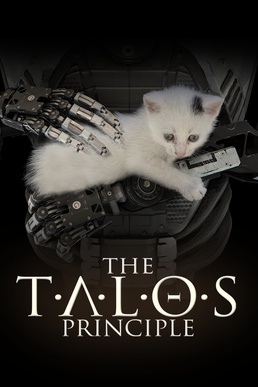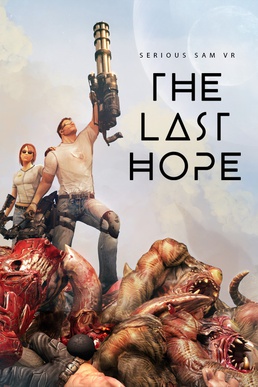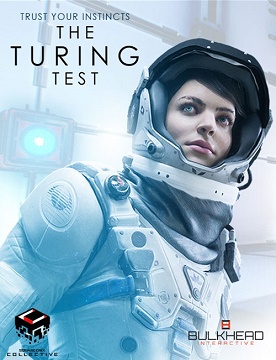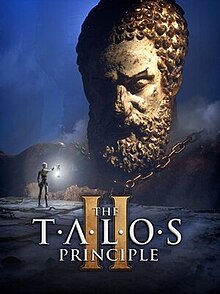
Puzzle video games make up a broad genre of video games that emphasize puzzle solving. The types of puzzles can test problem-solving skills, including logic, pattern recognition, sequence solving, spatial recognition, and word completion. Many puzzle games involve a real-time element and require quick thinking, such as Tetris (1985) and Lemmings (1991).

Riven: The Sequel to Myst is a puzzle adventure video game, the second in the Myst series of games. Developed by Cyan Worlds, it was initially published by Red Orb Entertainment, a division of Broderbund. Riven was distributed on five compact discs and released for Mac and Windows personal computers on October 31, 1997, in North America; it was later released on a single DVD-ROM in 1998. Riven was also ported to several other platforms. The story of Riven is set after the events of Myst. Having been rescued from the efforts of his sons, Atrus enlists the help of the player character to free his wife from his power-hungry father, Gehn. Riven takes place almost entirely on the Age of Riven, a world slowly falling apart due to Gehn's destructive rule.

Prisoner of Ice is an adventure game developed and released by Infogrames Multimedia for IBM PC compatibles and Macintosh in 1995 in America and Europe. It is based on H. P. Lovecraft's Cthulhu Mythos, particularly At the Mountains of Madness, and is a follow-up to Infogrames' earlier Shadow of the Comet. In 1997, the game was ported to the Sega Saturn and PlayStation exclusively in Japan.

Gobliiins is a puzzle adventure video game series, consisting of five entries, released by Coktel Vision for the Amiga, Atari ST, DOS, and Macintosh platforms. The first three titles were released in the early 1990s, the fourth in 2009. The visual look of the series and its characters were created by French artist Pierre Gilhodes, whose style was used in another game from Coktel Vision: Woodruff and the Schnibble of Azimuth.
Croteam is a Croatian video game developer based in Zagreb. The company was established by Davor Hunski, Damir Perović, Roman Ribarić and Dean Sekulić, four former classmates, in late August 1992. Croteam is best known for Serious Sam, a series of first-person shooters introduced with Serious Sam: The First Encounter in 2001. The company also developed the 2014 puzzle game The Talos Principle and its 2023 sequel The Talos Principle 2. Croteam employed approximately 40 people in 2020 and was acquired by its long-time publishing partner Devolver Digital in October that year.

Rama is a point and click adventure game, developed and published by Sierra On-Line, and released on DOS and Microsoft Windows in 1996; PlayStation version was released in 1998, but exclusively in Japan. The game is based upon Arthur C. Clarke's books Rendezvous with Rama and Rama II, combining elements of their plots with a story that sees the player assuming the role of a replacement crew member for an expedition to investigate an instellar ship and uncover its mysteries.
An escape room video game, also known as escape the room, room escape, or escape game, is a subgenre of point-and-click adventure game which requires a player to escape from imprisonment by exploiting their surroundings. The room usually consists of a locked door, objects to manipulate, and hidden clues or secret compartments. The player must use the objects to interact with other items in the room to reveal a way to escape. Escape the room games were born out of freeware browser games created in Adobe Flash, but have since become most popular as mobile games for iOS and Android. Some examples include Crimson Room, Viridian Room, MOTAS, and Droom. The popularity of these online games has led to the development of real-life escape rooms all around the world.

Sphinx and the Cursed Mummy is a 2003 action-adventure video game developed by Eurocom and published by THQ for GameCube, PlayStation 2, and Xbox. A version for mobile phones was released in 2004. THQ Nordic published a high-definition remaster for personal computer systems in 2017, and Nintendo Switch in 2019.

Professor Layton and the Diabolical Box, known in Australia and Europe as Professor Layton and Pandora's Box, is the second game in the Professor Layton series by Level-5. It was followed by a third game, Professor Layton and the Unwound Future. The game follows Professor Layton and his self-proclaimed apprentice Luke as they travel cross-country by train to solve the mystery behind a mysterious box that is said to kill anyone who opens it. An enhanced mobile port of Diabolical Box, subtitled "HD for Mobile", was released on December 5, 2018.

Space Trader is a strategy game for Palm OS and Windows Mobile PDAs. It was released in 2002 by Pieter Spronck, a scientist at Tilburg University, and was inspired by David J. Webb's PalmPilot game SolarWars and the 1980s classic 3D strategy game Elite. The game is free software under the GNU General Public License. It has since been ported to various other Platforms by other people as well.

Puzzle Quest 2 is a video game developed by Infinite Interactive for the Nintendo DS, Xbox Live Arcade, iOS, Android, Windows Phone 7, and Microsoft Windows. It was released on June 22, 2010 by D3 Publisher. A version for the PlayStation Portable was in development, but was cancelled due to sound bugs. It is the sequel to Puzzle Quest: Challenge of the Warlords, and like its predecessor, it combines role-playing with strategy and puzzle elements. It uses a competitive, Bejeweled-style, "match three game" playfield to simulate combat and other activities common to role-playing games.

The Room Two is a puzzle video game developed by British-based Fireproof Games as a sequel to The Room. The game was originally developed for the iPad and released in December 2013; it was made universal to work with the iPhone in January 2014. The Android version was released in February 2014. A Windows version was released on 5 July 2016. An Apple Arcade version, named «The Room Two+», was released on 2 April 2021. It was also released for Nintendo Switch in August 2022.
Borderlands is an action role-playing first-person looter shooter video game franchise set in a space Western science fantasy setting, created and produced by Gearbox Software and published by 2K for multiple platforms.

Borderlands: The Pre-Sequel is an action role-playing first-person shooter video game developed by 2K Australia, with assistance from Gearbox Software and published by 2K. It is the third game in the Borderlands series, and is a spin-off set after 2009's Borderlands and before 2012's Borderlands 2. It was released for Linux, OS X, PlayStation 3, Windows, and Xbox 360 on 14 October 2014. Updated ports for Windows, PlayStation 4 and Xbox One were released as part of Borderlands: The Handsome Collection on 24 March 2015.

The Talos Principle is a 2014 puzzle video game developed by Croteam and published by Devolver Digital. It was simultaneously released on Linux, OS X and Windows in December 2014. It was released for Android in May 2015, for PlayStation 4 in October 2015, for iOS in October 2017, for Xbox One in August 2018, and Nintendo Switch in December 2019. Virtual reality-enabled versions for the Oculus Rift and HTC Vive were released on 18 October 2017. A DLC entitled Road to Gehenna was released on 23 July 2015.

Human Resource Machine is a visual programming-based puzzle video game developed by Tomorrow Corporation. The game was released for Microsoft Windows, OS X and Wii U in 2015, being additionally released for Linux in March 2016, for iOS in June 2016, for Android in December 2016 and for the Nintendo Switch in March 2017. Human Resource Machine uses the concept of a corporate office worker assigned to perform tasks that involve moving objects between an inbox, an outbox, and to and from storage areas as a metaphor for assembly language concepts. The player works through some forty puzzles in constructing a program to complete a specific task.

Serious Sam VR: The Last Hope is a 2017 first-person shooter game for virtual reality (VR) developed by Croteam VR and published by Devolver Digital. One or two players fight waves of enemies, including bosses, across five thematic planets. The enemies approach from a 180° field and the player can use dual-wielded weapons while moving across a limited space. To develop The Last Hope and experiment with other VR implementations, Croteam VR was established as a specialised division of Croteam. Devolver Digital announced the game at E3 in June 2016 and launched it in early access that October. After several updates, it was released in September 2017 for Windows with compatibility for the HTC Vive and Oculus Rift VR headsets. The Last Hope received mostly positive reviews, with post-release reception lauding the game's gameplay and visuals while criticising difficulty spikes and issues with the online multiplayer mode.

The Turing Test is a first-person puzzle video game developed by Bulkhead Interactive and published by Square Enix Collective. The game was released for Microsoft Windows and Xbox One in August 2016, for PlayStation 4 in January 2017, for Nintendo Switch in February 2020, and for Stadia in May 2020.

Serious Sam 4 is a 2020 first-person shooter developed by Croatian studio Croteam and published by Devolver Digital. It is part of the Serious Sam series and a prequel to Serious Sam 3: BFE. The game was announced in April 2018, originally as Serious Sam 4: Planet Badass, was released in September 2020 for Microsoft Windows and Stadia, followed by PlayStation 5 and Xbox Series X/S ports in December 2021. A standalone expansion, Serious Sam: Siberian Mayhem, was released in January 2022.

I Expect You to Die2: The Spy And The Liar is a virtual reality action puzzle video game developed and published by Schell Games. The game is a sequel to the original I Expect You to Die (2016), and follows the same protagonist, an agent that must use items within a limited environment to solve puzzles to progress through the game. The plot revolves around the player going through various hurdles as to stop Zoraxis, a megacorporation, from taking over the world. The game was released in 2021 to generally positive reviews from critics.

















